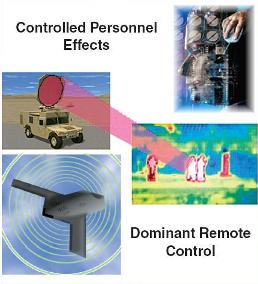Entered into the database on Friday, February 24th, 2006 @ 19:27:16 MST
The brain has always been a battlefield. New weapons might be able
to hack directly into your nervous system. "Controlled
Effects" (see image, right) is one of the Air Force’s ambitious
long-term challenges. It starts with better and more accurate bombs, but moves
on to discuss devices that "make selected adversaries think or act according
to our needs... By studying and modeling the human brain and nervous system,
the ability to mentally influence or confuse personnel is also possible." The first stage is technology to “remotely create physical sensations.”
They give the example of the Active
Denial System "people zapper" which uses a high-frequency radiation
similar to microwaves as a non-lethal means of crowd control. Other weapons can affect the nervous system directly. The Pulsed
Energy Projectile fires a short intense pulse of laser energy. This vaporizes
the outer layer of the target, creating a rapidly-expanding expanding ball of
plasma. At different power levels, those expanding plasmas could deliver a harmless
warning, stun the target, or disable them - all with pinpoint laser precision
from a mile away. Early reports on the effects of PEPs
mentioned temporary paralysis, then thought to be related to ultrasonic shockwaves.
It later became apparent that the electromagnetic pulse caused by the expanding
plasma was triggering nerve cells. Details of this emerged in a heavily-censored
document released to Ed Hammond of the Sunshine
Project under the Freedom if Information Act. Called “Sensory consequence
of electromagnetic pulsed emitted by laser induced plasmas,” it described
research on activating the nerve cells responsible for sensing unpleasant stimuli:
heat, damage, pressure, cold. By selectively stimulating a particular nociceptor,
a finely tuned PEP might sensations of say, being burned, frozen or dipped in
acid -- all without doing the slightest actual harm. The skin is the easiest target for such stimulation. But, in principle, any
sensory nerves could be triggered. The Controlled Effects document suggests
“it may be possible to create synthetic images…to confuse an individual'
s visual sense or, in a similar manner, confuse his senses of sound, taste,
touch, or smell.” In other words, it may be possible to use electromagnetic means to create overwhelming
'sound' or 'light', or indeed 'intolerable smell' which would exist only in
the brain of the person perceiving them. There is another side as well. The “sensory consequences” document
also notes that the nervous system which controls muscles could be influenced
to cause what they call “Taser-like motor effects.” The stun gun’s
ability to shock the muscles into malfunction is relatively crude; we might
now be looking at are much more targeted effects.
